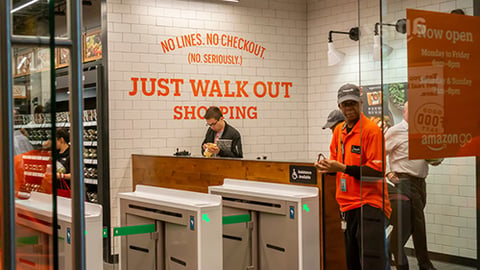3 Ways for Grocers to Keep Their Edge in the Market
People still buy their groceries in-store, as they have for decades. Grocery today is predominantly reliant on brick-and-mortar business, with 95% of fast-moving consumer goods sales and 98% of food sales occurring in-store. But, as many industries have brought their inventory and their advertising online, grocery stores have lagged. Top grocers in the United States are commonly a century old, but their marketing and measurement tactics don’t have to be. There’s a huge opportunity afoot for the grocery industry to capitalize on the values of digital advertising without sacrificing their tried-and-true commitment to in-store experiences.
1. Understand the competitive digital landscape
While only 2% to 5% of grocers’ sales occur online, grocery is also among the largest-growing ecommerce segments year over year, with 18.2% growth expected this year. Additionally, while total sales volume is only 2%, many people have bought groceries online. In fact, 23% of all people have ever purchased groceries through ecommerce channels. What this indicates is that, while a good portion of people have tried purchasing groceries online, most people still prefer to buy their food in stores.
Despite retail owning most of the industry, ecommerce growth poses an opportunity and a potential problem for the grocery industry. Direct-to-consumer meal kits are growing, as are grocery delivery services like Amazon Fresh, Instacart and FreshDirect. These brands grew up in the internet age and understand the tactics required to keep up in a digital world. The two biggest grocery brands in the United States by sales volume – Kroger and Albertsons – were founded in 1883 and 1939, respectively. That’s not to say that these brands are out of touch with modern-day marketing, just that the internet age isn’t built into their DNA.
2. Maximize modern marketing tactics
These days, there’s a seemingly endless list of advertising channels for brands to consider. A long time ago, word of mouth was the best advertising a company could expect. Now things are a bit different. Comparing word-of-mouth referrals in five of the biggest industries, including technology, beauty and beverages, it was grocery that experienced the smallest proportion (only 6%) of consumer sales driven by offline word of mouth. There’s an obvious disparity between how people shop for groceries (in-store) and how they learn about grocery brands.
Grocery stores are still spending a huge portion of their marketing dollars on circulars – nearly 57%. According to some studies, almost one-fifth of grocery retailers expect to discontinue circulars within five years. About 40% of those respondents expect the change to happen much sooner, within two years.
So the sentiment around adoption is already there for grocery retailers. But the question is, why wait? If it takes five years to reallocate budget to an advertising channel with better performance, how much missed opportunity does that represent?
Digital marketing can be highly effective for brick-and-mortar stores, but to optimize the positive benefits of digital campaigns, these campaigns must link back to real-world actions.
3. Measure real-world results
To maximize the value of modern marketing, advertisers must heed the fact that retail is still alive and well in this industry. So what’s a digital marketer to do? Implement digital campaigns that use modern-day devices (cellphones) to measure old-school, real-world results, i.e., number of visits, visit frequency and dwell time. Location data tells a whole new story about performance than was ever before possible.
The next big thing for the grocery industry will be an overhaul of marketing tactics such that measurement and performance take precedence over the old way of doing things.
The brands that adapt quickly and invest in performance will be significantly ahead of the curve in gaining and maintaining market share. The brands that lag may see their margins – and their long runs in business – cut short.







